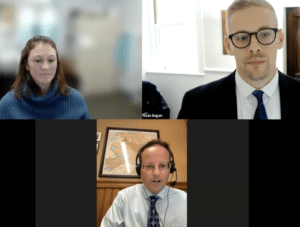Who is a member?
Our members are the local governments of Massachusetts and their elected and appointed leadership.

An MMA webinar discussed how to effectively communicate with constituents and customize outreach according to your target audience. Speakers included (clockwise from top left) Tyngsborough Assistant Town Manager Kat Foster, Easton Assistant Town Administrator Sean Dugan and Cambridge Director of Media Relations and Content Strategy Jeremy Warnick.
An MMA webinar yesterday discussed how to effectively communicate with constituents and customize outreach according to your target audience.
Sean Dugan, the assistant town administrator in Easton, said transparent communication is essential to success in local government. Communication coming from city and town halls should provide timely, accurate, and complete information so the public can make informed decisions about their community and daily life.
Jeremy Warnick, the director of media relations and content strategy in Cambridge, said the digital age has shifted how residents interact with municipalities, as they now have powerful tools to voice their opinions and demand transparent communication.
“Residents are our customers, and we should operate from the mindset that we owe it to them to be upfront about the work we do and should make it easy for them to do business with us,” Warnick said.
The panelists reviewed the basics of public engagement, and encouraged an active and intentional two-way dialogue between the public and governmental agencies.
“Outreach is not engagement,” Dugan said. “It’s one-way communication that doesn’t collect feedback.”
Municipalities should make a conscious effort to engage residents throughout decision-making processes, he said, to keep them informed of key milestones and build pride in community projects.
Dugan explained the spectrum of engagement, which helps determine when projects require the judgment and knowledge of stakeholders and community members. Depending on the level of engagement the project warrants, different types of communication should be used to enhance community commitment.
Panelists also discussed the importance of “being your own newsroom,” given that information-sharing and engagement will build trust with community members. Warnick said it’s imperative for municipalities to invest in effective digital tools and use them regularly, while still integrating non-digital methods in order to maximize reach. Not every piece of information can go out on every platform, he said, so it’s important to know the audience and tailor messaging to cover all the bases.
Dugan and Warnick recommended that attendees collect feedback and review analytics to determine which channels generate the most engagement with community members.
Tyngsborough Assistant Town Manager Kat Foster moderated the question and answer session, when attendees asked about managing a surplus of disinformation, communicating with “offline residents,” and centralizing engagement across municipal departments.
• Effective Constituent Communication: The Key to Fostering Public Engagement presentation (2M PDF)